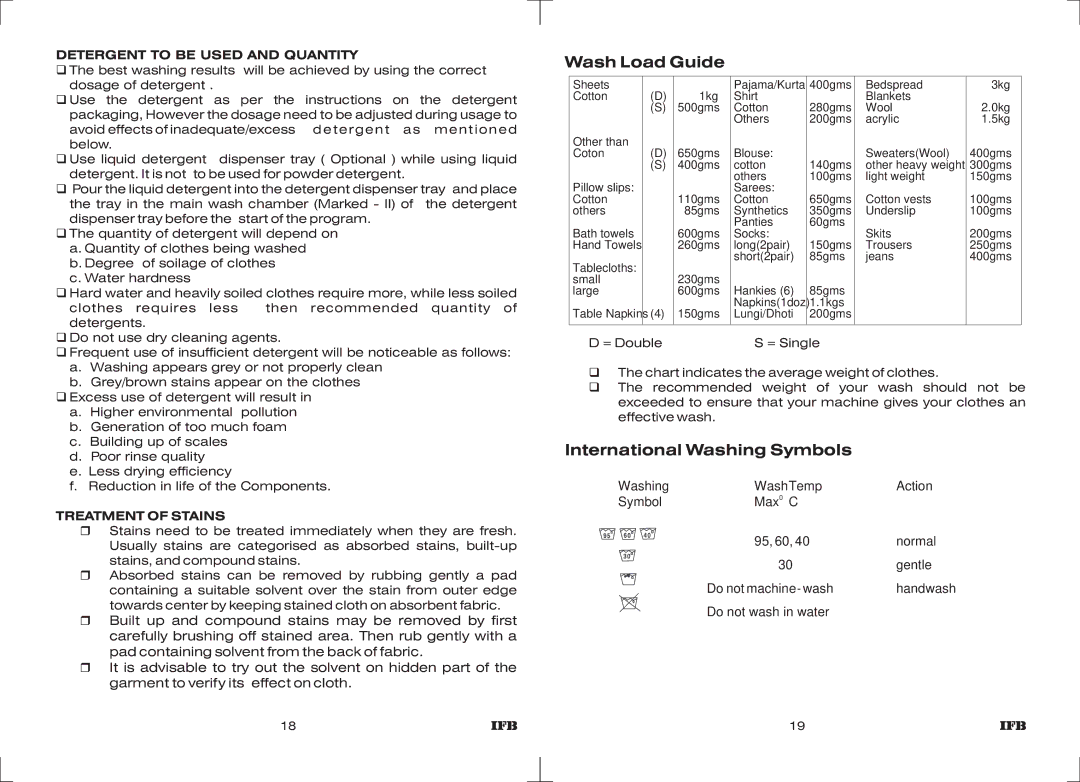DETERGENT TO BE USED AND QUANTITY
qThe best washing results will be achieved by using the correct dosage of detergent .
qUse the detergent as per the instructions on the detergent packaging, However the dosage need to be adjusted during usage to
avoid effects of inadequate/excess detergent as mentioned below.
qUse liquid detergent dispenser tray ( Optional ) while using liquid detergent. It is not to be used for powder detergent.
qPour the liquid detergent into the detergent dispenser tray and place
the tray in the main wash chamber (Marked - II) of the detergent dispenser tray before the start of the program.
qThe quantity of detergent will depend on a. Quantity of clothes being washed
b. Degree of soilage of clothes c. Water hardness
qHard water and heavily soiled clothes require more, while less soiled
clothes requires less then recommended quantity of detergents.
qDo not use dry cleaning agents.
Frequentuse of insufficient detergent will be noticeable as follows:
a.Washing appears grey or not properly clean
b.Grey/brown stains appear on the clothes
qExcess use of detergent will result in
a.Higher environmental pollution
b.Generation of too much foam
c.Building up of scales
d.Poor rinse quality
e.Less drying efficiency
f.Reduction in life of the Components.
TREATMENT OF STAINS
rStains need to be treated immediately when they are fresh. Usually stains are categorised as absorbed stains,
rAbsorbed stains can be removed by rubbing gently a pad containing a suitable solvent over the stain from outer edge towards center by keeping stained cloth on absorbent fabric.
rBuilt up and compound stains may be removed by first carefully brushing off stained area. Then rub gently with a pad containing solvent from the back of fabric.
rIt is advisable to try out the solvent on hidden part of the garment to verify its effect on cloth.
Wash Load Guide
Sheets |
|
| Pajama/Kurta | 400gms | Bedspread | 3kg |
Cotton | (D) | 1kg | Shirt |
| Blankets |
|
| (S) | 500gms | Cotton | 280gms | Wool | 2.0kg |
|
|
| Others | 200gms | acrylic | 1.5kg |
Other than |
|
|
|
|
|
|
Coton | (D) | 650gms | Blouse: |
| Sweaters(Wool) | 400gms |
| (S) | 400gms | cotton | 140gms | other heavy weight | 300gms |
|
|
| others | 100gms | light weight | 150gms |
Pillow slips: |
|
| Sarees: |
|
|
|
Cotton |
| 110gms | Cotton | 650gms | Cotton vests | 100gms |
others |
| 85gms | Synthetics | 350gms | Underslip | 100gms |
|
|
| Panties | 60gms |
|
|
Bath towels |
| 600gms | Socks: |
| Skits | 200gms |
Hand Towels |
| 260gms | long(2pair) | 150gms | Trousers | 250gms |
Tablecloths: |
|
| short(2pair) | 85gms | jeans | 400gms |
|
|
|
|
|
| |
small |
| 230gms |
|
|
|
|
large |
| 600gms | Hankies (6) | 85gms |
|
|
|
|
| Napkins(1doz) | 1.1kgs |
|
|
Table Napkins (4) | 150gms | Lungi/Dhoti | 200gms |
|
| |
D = Double |
| S = Single |
|
| ||
qThe chart indicates the average weight of clothes. qThe recommended weight of your wash should not be
exceeded to ensure that your machine gives your clothes an effective wash.
International Washing Symbols
Washing | Wash Temp | Action |
Symbol | Max0 C |
|
| 95, 60, 40 | normal |
| 30 | gentle |
| Do not machine - wash | handwash |
| Do not wash in water |
|
18 | 19 |
